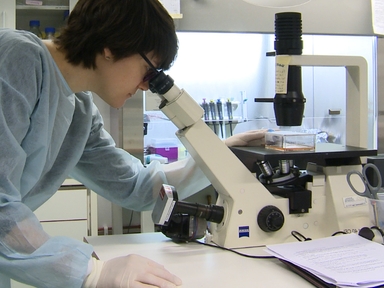Evaluating Cytotoxicity and Membrane Integrity in Lung Slices via Lactate Dehydrogenase Assay
Transcript
Begin with human precision-cut lung slices, PCLS, treated with cytotoxic agents like surfactant molecules in a multiwell plate.
The surfactant inserts into the lipid bilayer of the cell, causing the hydrophobic tails of the surfactant to interact with the hydrophobic core of the lipid bilayer.
Consequently, the orderly arrangement of the lipid molecules is disturbed, leading to the formation of a micelle.
This compromises the membrane integrity, causing the leakage of intracellular contents including, lactate dehydrogenase or LDH, a common indicator of cell membrane damage.
Collect the supernatant containing the released LDH.
Add the LDH assay reaction cocktail containing lactate substrate, NAD+, diaphorase, and tetrazolium salt, and incubate.
LDH oxidizes lactate to pyruvate, with simultaneous reduction of NAD+ coenzyme to NADH.
Diaphorase utilizes the NADH to reduce the tetrazolium salt into formazan — a colored product.
Surfactant-induced cytotoxicity can be measured from LDH activity indicated by the formazan production.
Related Videos

A Plate-based Cytotoxicity Assay for the Assessment of Rat Placental Natural Killer Cell Cytolytic Function

Accessing the Cytotoxicity and Cell Response to Biomaterials

The Lactate Dehydrogenase Sequestration Assay — A Simple and Reliable Method to Determine Bulk Autophagic Sequestration Activity in Mammalian Cells
ABOUT JoVE
Copyright © 2024 MyJoVE Corporation. All rights reserved